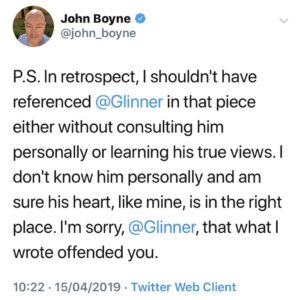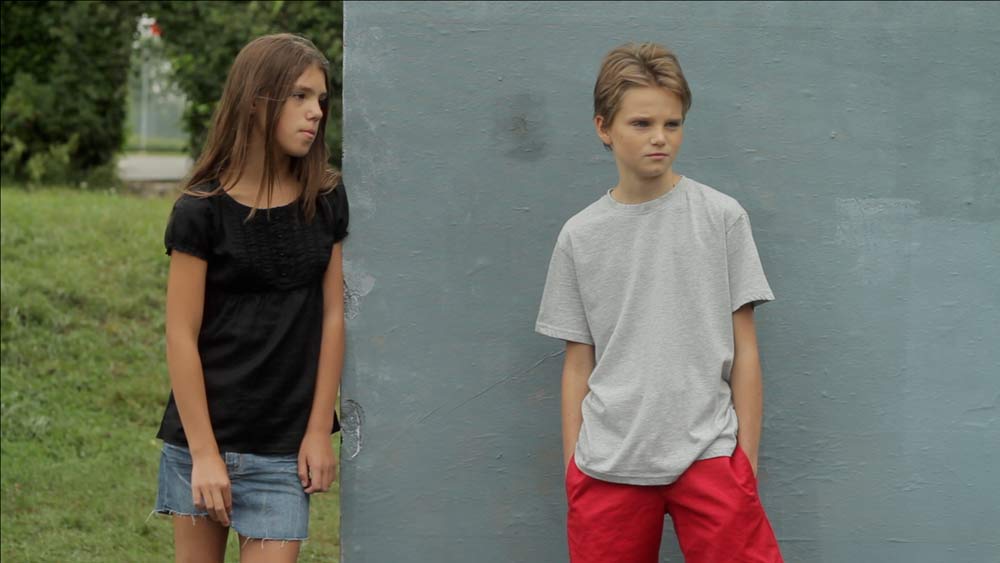The letters that make up the LGBTQ community suggest a sort of unity among the various gay & gender diverse subsections. This of course, puts aside the fact that all of the letters have vastly different experiences. Intersectionality is vital toward understanding that while we may all be part of the same umbrella term, each of us faces different levels of inequality.
Irish author John Boyne, a gay cisgender man, has recently written a novel titled My Brother’s Name is Jessica about a boy who discovers that his sibling has a gender identity different than the one assigned at birth. One could take umbrage with the title, which misgenders a transgender woman, or the idea that Boyne is writing about transgender issues despite not being transgender, but perhaps more concerning is an op-ed Boyne recently published. The piece which decries the use of the word “cis” in its title, defends tennis star Martina Navratilova for comments she herself has apologized for, and equivocates on the bigotry of TV writer turned obsessive anti-trans keyboard cowboy Graham Linehan among other things is far more concerning.
The word cisgender has been used by the scientific for decades despite Boyne’s claim that it’s “given by trans people to their nontransgender brethren.” In fact, “cis” draws its origins from Latin, meaning “on this side of,” to refer to people whose gender identity matches the sex they were designated at birth. “Cis” is to gender identity what “straight” is to sexuality. It’s kind of a clunky word, one that I criticize in The Transgender Manifesto, but thankfully for cisgender people, society at large doesn’t really expect them to use it very often, almost always in relation to transgender people.
Naturally, “cis” has received backlash from many anti-transgender people, who created the #cisisaslur hashtag to protest the scientific term. Boyne seems totally on board with this mentality, writing, “I don’t consider myself a cis man; I consider myself a man.” On the surface level, one can kind of see his point, cis being an unnecessary term that doesn’t fundamentally change the way society views him. Trouble is, this mentality perpetuates the notion that cisgender is the “default setting.” It’s not fundamentally any different from a white man demanding that no one refer to him as white or a straight person insisting that people only refer to them as normal.
Similarly tone deaf is Boyne’s defense of Navratilova. Navratilova, seen for decades as a champion of gay rights, published an op-ed in The Times where she referred to transgender athletes as “cheats” and regarded the very notion of allowing them to compete as “insane.” Navratilova later apologized for her remarks after being dropped as an ambassador for Athlete Ally, an LGBTQ nonprofit.
Boyne presents Navratilova’s narrative as something completely unworthy of criticism, writing, “For anyone to suggest that a person of her courage is phobic about anything is to deliberately ignore her history.” Such a mindset presents a strange either/or scenario. Navratilova has quite obviously been a champion of gay rights, but that doesn’t change the prejudiced nature of her mentality toward transgender athletes who are frequently portrayed as imposters seeking to game the system. The recent media obsession with transgender athletes ignores the fact that not a single transgender athlete has competed in the Olympics since the IOC started permitting trans athletes back in 2003. While anti-transgender pundits frequently warn of a transgender take-over in sports, they seem decidedly unsure of when such an invasion is actually going to occur.
It’s one thing for Boyne to continue supporting Navratilova, an iconic tennis star and someone who has done a lot of legitimate good for gay athletes, but such praise does not need to diminish the hurtful words that she rightly issued an apology for. Boyne’s words talk over the transgender community who face plenty of discrimination in sport, and pointlessly attempt to frame transphobic comments as something other than bigoted. A person who cared about intersectionality might have left well enough alone, but Boyne felt the need to chime in on a matter than didn’t call for comment from a gay man completely unaffected by her words.
Boyne’s reaction to his op-ed has further perpetuated the idea that he doesn’t actually care about the transgender community he writes about. Boyne tweeted that he would engage with comments that weren’t “rude” or “aggressive” but most of his replies were aimed at people praising him, including a few anti-transgender accounts.
My own reply, which received over a hundred likes, went unanswered.
This wouldn’t be much of an issue if Boyne hadn’t found the time to apologize to noted obsessive transphobe Graham Linehan for including him in the op-ed. Linehan. Oddly enough, Boyne’s apology was later deleted, preserved by screenshot.

The idea that he made time for Linehan, who tried to strip funding for a transgender children’s charity and has been warned by the police for anti-transgender harassment among other things, suggests that Boyne doesn’t have much regard for the community he spends his time writing about. Anyone wondering where Linehan’s heart is located doesn’t need to look further than his Twitter feed.
I can get that Boyne is upset about the reaction to his op-ed. No one like to feel piled on, but instead of introspection, Boyne has instead dug into the notion that his critics are merely rude or aggressive. Such tone-policing ignores the broader issue, that Boyne’s words were misguided, hurtful, and ignorant of a community he’s currently attempting to represent in his own work.
Intersectionality reminds us of the importance of engaging with people whose perspective differ from one’s own. Boyne doesn’t seem to care to engage with the transgender community over his comments or his book. A man who displays more concern for the critics of transgender people than the community itself is probably not the best person to be dramatizing our lives in novels. His lazy concern for trans rights has no place in the public discourse, a pathetic attempt to monetize a group of people he otherwise demonstrates nothing but disdain toward.

















